GuLoader TL;DR
GuLoader is a polymorphic shellcode loader packed full of anti-analysis and anti-vm techniques to evade detection. The malware began as a Visual Basic (VB) 5/6 downloader, first identified in 2019. VB served as a wrapper for the core component implemented in shellcode until late last year. GuLoader began experimenting with a variety of delivery methods including VBS and macro-enabled documents before introducing NSIS (Nullsoft Scriptable Install System) in 2022. GuLoader and its delivery mechanisms are frequently updated by the authors to inhibit analysis and make detection more difficult. GuLoader typically delivers Remote Access Tools such as Remcos, but has been observed delivering numerous different malware families. Let’s attempt to navigate this mess of anti-analysis techniques together.
SHA256: ee548086db277e0febd2797b582a734ac451a9cd050540d2a1fd08afa6232721
NSIS Installer
NSIS Primer
A NSIS script is a regular text file with a special syntax. A script file contains Installer Attributes, Pages and Sections and Functions. Each line is treated as a command. The following section provides essential knowledge required to analyze a NSIS script. For additional details, see the following link.
Installer Attributes
Installer attributes determine the behavior, look and feel of the installer. These attributes can change text shown during installation, the number of installation types, etc. An example of an Installer Attribute is:
AddBrandingImage left 100Pages
A non-silent installer has a set of wizard pages that let the user configure the installer. The Page command is used to set pages to be displayed. A typical set of pages looks like this:
Page license
Page components
Page directory
Page instfiles
UninstPage uninstConfirm
UninstPage instfilesSections
Installers commonly have multiple options available to the user during installation. For example, an installer may allow the user to install additional tools, plug-ins, examples and more. Each of these components has corresponding code. If the user selects to install this component, then the installer will execute the respective code for that component. In a script, that code is defined in sections.
Instructions used in sections are different from instructions for installer attributes. They are executed at runtime on the user’s computer and can extract files, read from and write to the registry, INI files or normal files, create directories, create shortcuts and more. See Instructions for more information. An example of a section looks like this:
Section "My Program"
SetOutPath $INSTDIR
File "My Program.exe"
File "Readme.txt"
SectionEndFunctions
Functions, like Sections, contain script code. The difference between sections and functions is the way in which they are called. There are two types of functions: user functions and callback functions.
User functions are called from Sections by the user or other functions using the Call instruction. User functions will not execute unless you call them. After the code in the function has executed, the installer will continue executing the instructions that came after the Call instruction, unless installation has been aborted inside the function. User functions are useful if an installer contains a set of instructions that need to be executed in several locations of the installer. Example user function:
Function Hello
DetailPrint "Hello world"
FunctionEndCallback functions are called by the installer upon certain defined events, such as when the installer starts. Callbacks are optional. Example callback function:
Function .onInit
MessageBox MB_YESNO "This will install My Program. Do you wish to continue?" IDYES gogogo
Abort
gogogo:
FunctionEndGuLoader NSIS Script
NSIS Script
The NSIS install script is located in the .nsi file, which is bundled in the executable.

The script is relatively small, containing 6 user functions, 1 callback function and 1 unused section. Though the script is small, the control flow of the script is intentionally convoluted, with junk commands sprinkled throughout. The callback function .onMouseOverSection serves as the entry point. The key commands from the entry point function are:
- Store file path
$INSTDIR\Skrivefelt172\Beskyttelsesprogram\Udledningstilladelses169\Gtteriernes.Thein var$_45_ - Store the value 41000 in var
$R1 - Store the value 1 in var
$R7 - Store the value 2893 in var
$1 - Store the file path
$INSTDIR\Arbejderklassernes.Atoin var$4

The callback function ends by calling func_36. func_36 contains a loop that extracts individual characters from Arbejderklassernes.Ato to build command strings to load and execute GuLoader shellcode. Control flow jumps between functions and labels, making analysis difficult to follow. The following commands are the key components for the loop.
- Open
$INSTDIR\Skrivefelt172\Beskyttelsesprogram\Udledningstilladelses169\Gtteriernesand store file handle in var$_46_. - Push
$_46_onto the stack and Pop$R2(store file handle in$R2) - Call
func_0to call FileSeek and move the file pointer to var$R1 - Read 1 byte from
$INSTDIR\Skrivefelt172\Beskyttelsesprogram\Udledningstilladelses169\Gtteriernesat file pointer location and store in var$_42_ - Push
$_42_onto the stack and Pop$1(store the byte read from the file in var$1 - Iterate index variable
$R1by 205 (file pointer + 205) - Copy Z into var
$R9 - Copy
$1(byte read from file) into var$0 - Loop condition: If
$0 is a not a Z, write the it to the registry keyHKCU Software\Allos Setupand loop again starting at label 37. If$0is a Z, callfunc_23to write the remaining value to the registry keyHKCU Software\Allos Setupand read the string stored in that key into var$R8, then callfunc_62to allocate memory usingSystem::Allocfollowed bySystem:Callto call the deobfuscated command that uses the Windows API to execute the GuLoader shellcode.

The resulting deobfuscated commands use the Windows API to:
- Load the file
$INSTDIR\Arbejderklassernes.Ato - Set the file pointer to offset 63101
- Allocate RWX memory of size 19456000
- Read shellcode starting from offset 63101 size 19456000 into the allocated RWX memory
- Execute GuLoader shellcode using EnumWindows callback function
kernel32::CreateFileA(m r4 , i 0x80000000, i 0, p 0, i 4, i 0x80, i 0)i.r5
kernel32::SetFilePointer(i r5, i 63101 , i 0,i 0)i.r3
kernel32::VirtualAlloc(i 0,i 19456000, i 0x3000, i 0x40)p.r2
kernel32::ReadFile(i r5, i r2, i 19456000,*i 0, i 0)i.r3
user32::EnumWindows(i r2 ,i 0)
GuLoader Shellcode
PEB Parsing and API Hashing
Shellcode Decrypt and Execute
The first section of shellcode is responsible for decrypting the stage one shellcode. GuLoader calculates an XOR key by performing arithmetic operations against a constant value, XOR decrypts the encrypted shellcode byte-by-byte, and transfers execution to the decrypted shellcode. The screenshots below show the XOR decrypt and the call eax instruction that executes the decrypted stage one shellcode.


Walking the PEB and Resolving Windows APIs
GuLoader does not have an Import Address Table (IAT) and therefore must manually resolve addresses of the functions it needs to execute. GuLoader walks the Process Environment Block (PEB) to locate base addresses of loaded modules and enumerates their export tables to find the desired Windows APIs . The PEB is always located at offset 0x30 (Win32) within the Thread Information Block (TIB).
typedef struct _PEB {
BYTE Reserved1[2];
BYTE BeingDebugged;
BYTE Reserved2[1];
PVOID Reserved3[2];
PPEB_LDR_DATA Ldr;
PRTL_USER_PROCESS_PARAMETERS ProcessParameters;
PVOID Reserved4[3];
PVOID AtlThunkSListPtr;
PVOID Reserved5;
ULONG Reserved6;
PVOID Reserved7;
ULONG Reserved8;
ULONG AtlThunkSListPtr32;
PVOID Reserved9[45];
BYTE Reserved10[96];
PPS_POST_PROCESS_INIT_ROUTINE PostProcessInitRoutine;
BYTE Reserved11[128];
PVOID Reserved12[1];
ULONG SessionId;
} PEB, *PPEB;Once a pointer to the PEB is acquired, the shellcode gets a pointer to the PEB_LDR_DATA structure, which is located at offset 0xC. Ldr contains an entry, InMemoryOrderModuleList, which is a doubly-linked list that contains the loaded modules for the process.

Each item in the list is a pointer to an LDR_DATA_TABLE_ENTRY structure, including the DllBase address and the DllName.
typedef struct _LDR_DATA_TABLE_ENTRY {
PVOID Reserved1[2];
LIST_ENTRY InMemoryOrderLinks;
PVOID Reserved2[2];
PVOID DllBase;
PVOID EntryPoint;
PVOID Reserved3;
UNICODE_STRING FullDllName;
BYTE Reserved4[8];
PVOID Reserved5[3];
union {
ULONG CheckSum;
PVOID Reserved6;
};
ULONG TimeDateStamp;
} LDR_DATA_TABLE_ENTRY, *PLDR_DATA_TABLE_ENTRY;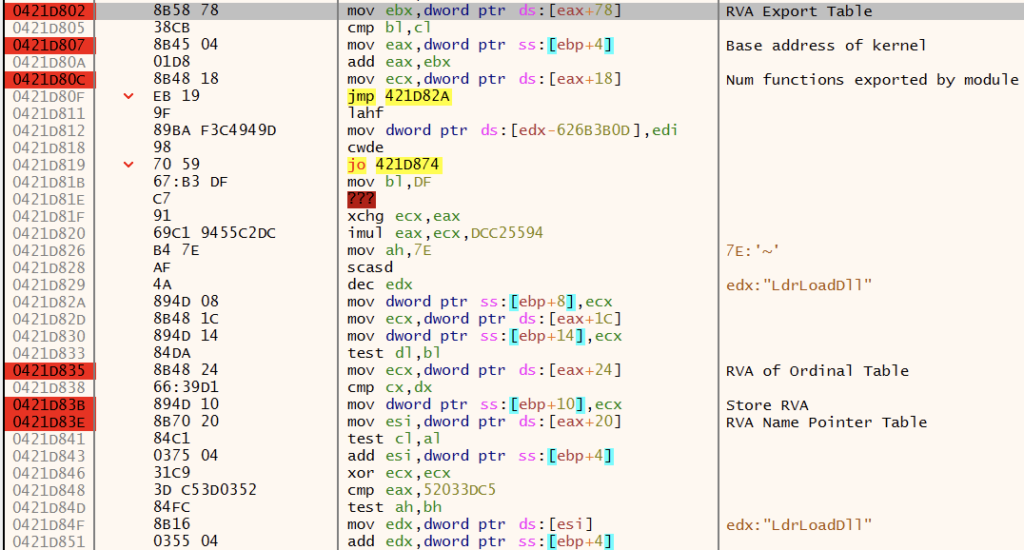
Once the DLL has been identified, GuLoader iterates the exports of the DLL in search of the desired API. GuLoader uses DJB2 to hash the name of the API and compare it against the pre-computed hash value. This method reduces the number of strings visible in memory, increasing the difficulty of detection.
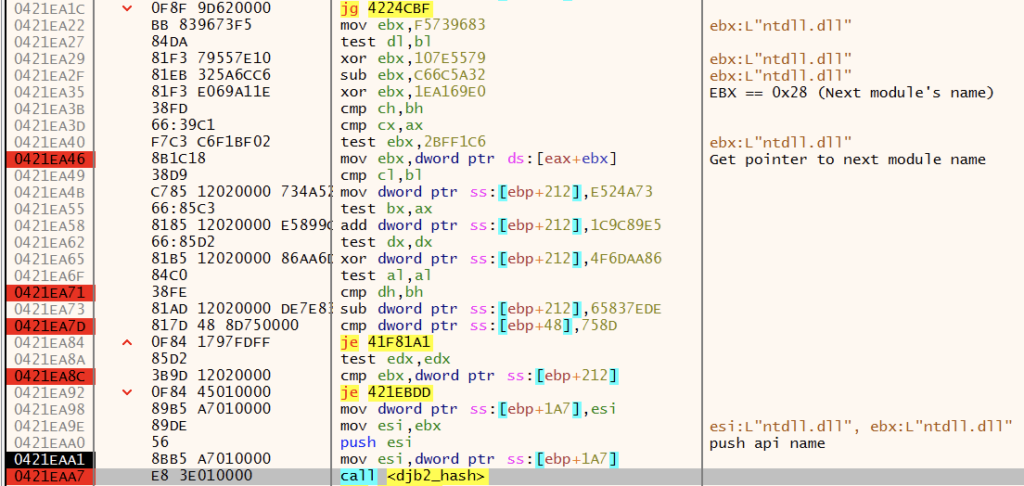
GuLoader leverages the DJB2 algorithm throughout the codebase to hash strings. The constant 5381 (0x1505) and instruction shl 5 are a clear indication of the use of the algorithm. Below is a representation of the algorithm,
unsigned long
hash(unsigned char *str)
{
unsigned long hash = 5381;
int c;
while (c = *str++)
hash = ((hash << 5) + hash) + c; /* hash * 33 + c */
return hash;
}GuLoader employs an additional XOR as part of its DJB2 algorithm for additional obfuscation. This ensures that the DJB2 hashes of specific APIs cannot be used for detection mechanisms such as Yara rules.

Vectored Exception Handler
GuLoader registers a custom vectored exception handler (VEH), using RtlAddVectoredException, as a control flow obfuscation technique to hinder analysis in debuggers and disassemblers. A VEH is an extension to structured exception handling that are not frame-based, therefore the VEH will be called for unhandled exceptions regardless of the location in a call frame. VEHs are called in the order they are added and can be designated to run first when registered via AddVectoredExceptionHandler.
PVOID AddVectoredExceptionHandler(
ULONG First,
PVECTORED_EXCEPTION_HANDLER Handler
);GuLoader calls RtlAddVectoredExceptionHandler with the First argument set to 1, which indicates the handler should be the first handler to be called. The VEH is used to control execution by dynamically calculating the address of EIP based on instructions following the address in which the exception occurred. GuLoader incorporates code throughout the shellcode that intentionally triggers the following three exceptions, causing the VEH code to execute.
0xC0000005 EXCEPTION_ACCESS_VIOLATION0x80000004 EXCEPTION_SINGLE_STEP0x80000003 EXCEPTION_BREAKPOINT
EXCEPTION_ACCESS_VIOLATION
GuLoader triggers access violation exceptions by performing mathematical operations on a constant stored in a register, then uses this value to attempt to write data the the [invalid] memory address referenced by this constant. This causes an access violation exception 0xC0000005, triggering the VEH.

EXCEPTION_SINGLE_STEP
Setting the Trap Flag is a well-known way to detect if a debugger is currently attached to a process. When the Trap Flag is set, a Single Step exception is raised. If a debugger is attached, it will handle the raised exception and continue execution. If a debugger is not attached, the exception will be handled by the exception handler, in this case, the GuLoader VEH.
The code below is an example of the code blocks located throughout the GuLoader shellcode that cause a Single Step exception 0x80000004. Constant obfuscation is used to conceal the value of 0x100, which is eventually stored in edx. pushfd is used to push the EFLAGS register to the top of the stack. Next, the value of the EFLAGS is calculated via or dword ptr ds:[edi] (0x206), edx (0x100), resulting in the value 0x306. 0x306 is 1100000110 in binary, meaning the bit in position 8 (Trap Flag) is set. Finally, pushfd pops the dword on top of the stack into the EFLAGS register, setting the Trap Flag and triggering a Single Step exception (when the debugger is not attached).

EXCEPTION_BREAKPOINT
The INT3 (0xCC) instruction is a single-byte instruction defined for use by debuggers to temporarily replace an instruction in a running program in order to set a breakpoint. When an INT3 instruction is executed, a breakpoint exception 0x80000003 is triggered and the VEH is executed. If a debugger is attached, the exception is handled by the debugger, the VEH is not called, and program execution is paused. Instructions following the INT3 instructions are often invalid, causing exceptions and breaking execution in the debugger.

GuLoader VEH
When an exception is thrown, the VEH receives an EXCEPTION_POINTER structure, which contains a pointer to the ExceptionRecord and ContextRecord.
typedef struct _EXCEPTION_POINTERS {
PEXCEPTION_RECORD ExceptionRecord;
PCONTEXT ContextRecord;
} EXCEPTION_POINTERS, *PEXCEPTION_POINTERS;The ExceptionRecord contains a machine-independent description of the exception. The most important member for the GuLoader VEH is the ExceptionCode, which is used to determine the code branch to execute in order to calculate EIP and continue execution.
typedef struct _EXCEPTION_RECORD {
DWORD ExceptionCode;
DWORD ExceptionFlags;
struct _EXCEPTION_RECORD *ExceptionRecord;
PVOID ExceptionAddress;
DWORD NumberParameters;
ULONG_PTR ExceptionInformation[EXCEPTION_MAXIMUM_PARAMETERS];
} EXCEPTION_RECORD;Once the ExceptionCode is identified, the VEH accesses the ContextRecord to retrieve EIP, then calculates a new EIP and continues execution using the following formula:
Exception_Access_ViolatonandException_Single_Step:eip = ((eip + 2) ^ 0xDB) + eipException_Breakpoint:eip = ((eip + 1) ^ 0xDB) + eip
Note: The XOR value changes in each sample of GuLoader.
typedef struct _CONTEXT {
DWORD64 P1Home;
DWORD64 P2Home;
DWORD64 P3Home;
DWORD64 P4Home;
DWORD64 P5Home;
DWORD64 P6Home;
DWORD ContextFlags;
DWORD MxCsr;
WORD SegCs;
WORD SegDs;
WORD SegEs;
WORD SegFs;
WORD SegGs;
WORD SegSs;
DWORD EFlags;
DWORD64 Dr0;
DWORD64 Dr1;
DWORD64 Dr2;
DWORD64 Dr3;
DWORD64 Dr6;
DWORD64 Dr7;
DWORD64 Rax;
DWORD64 Rcx;
DWORD64 Rdx;
DWORD64 Rbx;
DWORD64 Rsp;
DWORD64 Rbp;
DWORD64 Rsi;
DWORD64 Rdi;
DWORD64 R8;
DWORD64 R9;
DWORD64 R10;
DWORD64 R11;
DWORD64 R12;
DWORD64 R13;
DWORD64 R14;
DWORD64 R15;
DWORD64 Rip;
union {
XMM_SAVE_AREA32 FltSave;
NEON128 Q[16];
ULONGLONG D[32];
struct {
M128A Header[2];
M128A Legacy[8];
M128A Xmm0;
M128A Xmm1;
M128A Xmm2;
M128A Xmm3;
M128A Xmm4;
M128A Xmm5;
M128A Xmm6;
M128A Xmm7;
M128A Xmm8;
M128A Xmm9;
M128A Xmm10;
M128A Xmm11;
M128A Xmm12;
M128A Xmm13;
M128A Xmm14;
M128A Xmm15;
} DUMMYSTRUCTNAME;
DWORD S[32];
} DUMMYUNIONNAME;
M128A VectorRegister[26];
DWORD64 VectorControl;
DWORD64 DebugControl;
DWORD64 LastBranchToRip;
DWORD64 LastBranchFromRip;
DWORD64 LastExceptionToRip;
DWORD64 LastExceptionFromRip;
} CONTEXT, *PCONTEXT;
Anti-Analysis and Anti-Debug

Software Breakpoint Check
GuLoader performs anti-analysis/debug checks prior to calling Windows APIs by checking for breakpoints at the start of the function. When setting a software breakpoint on a function in a debugger, the debugger patches the first byte with a 0xCC, 0x3CD or 0xB0F, depending on the type of breakpoint selected, to trigger a software interrupt. GuLoader checks the first byte of the function for these values in order to detect software breakpoints. If detected, GuLoader jumps to code that crashes the process.
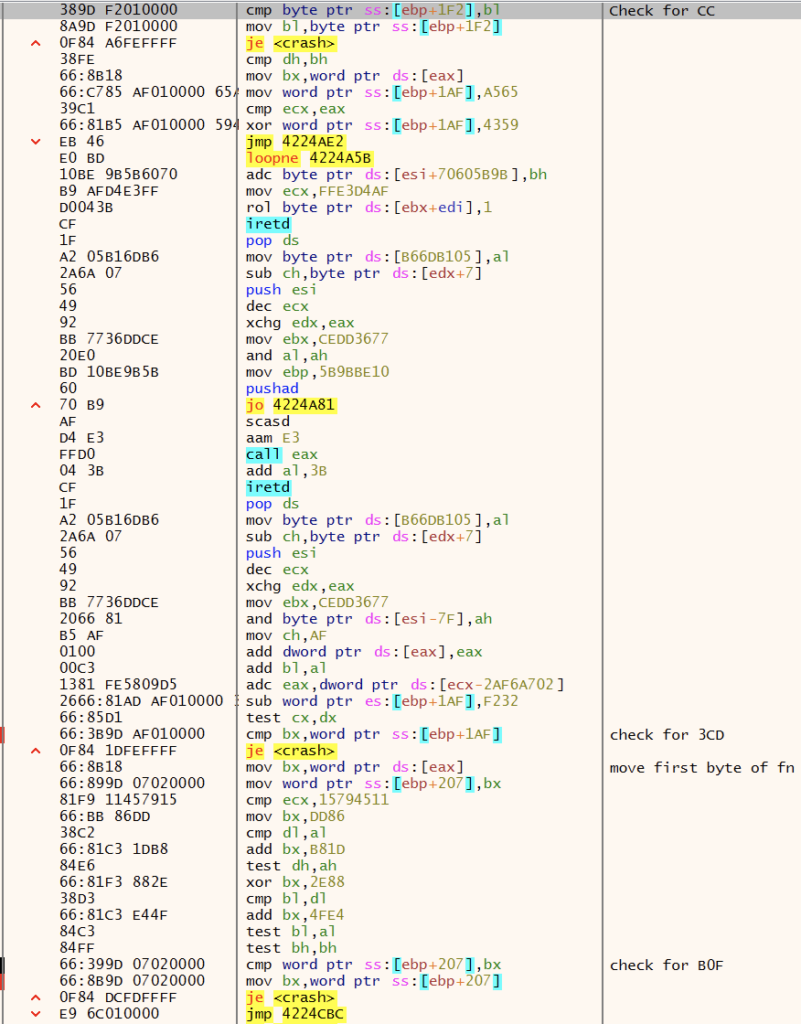
Scan Memory for Pre-Computed DJB2 Hashes of Strings
GuLoader scans the entire memory area using ZwQueryVirtualMemory from 0x00010000 to 0x7FFFF000 for strings indicating the malware is running in a virtualized environment or for various security tools.

ZwQueryVirtualmemory returns the MEMORY_BASIC_INFORMATION struct, which contains information including the BaseAddress as well as Protect, which describes current page protection.
typedef struct _MEMORY_BASIC_INFORMATION {
PVOID BaseAddress;
PVOID AllocationBase;
ULONG AllocationProtect;
USHORT PartitionId;
SIZE_T RegionSize;
ULONG State;
ULONG Protect;
ULONG Type;
} MEMORY_BASIC_INFORMATION, *PMEMORY_BASIC_INFORMATION;GuLoader access the State member, looking for memory pages with protection PAGE_EXECUTE, PAGE_EXECUTE_READ, PAGE_EXECUTE_READWRITE, PAGE_WRITE, and PAGE_READWRITE (not pictured). GuLoader then scans the identified memory pages for strings, hashes the string using DJB2 and compares the hash against pre-computed hashes.

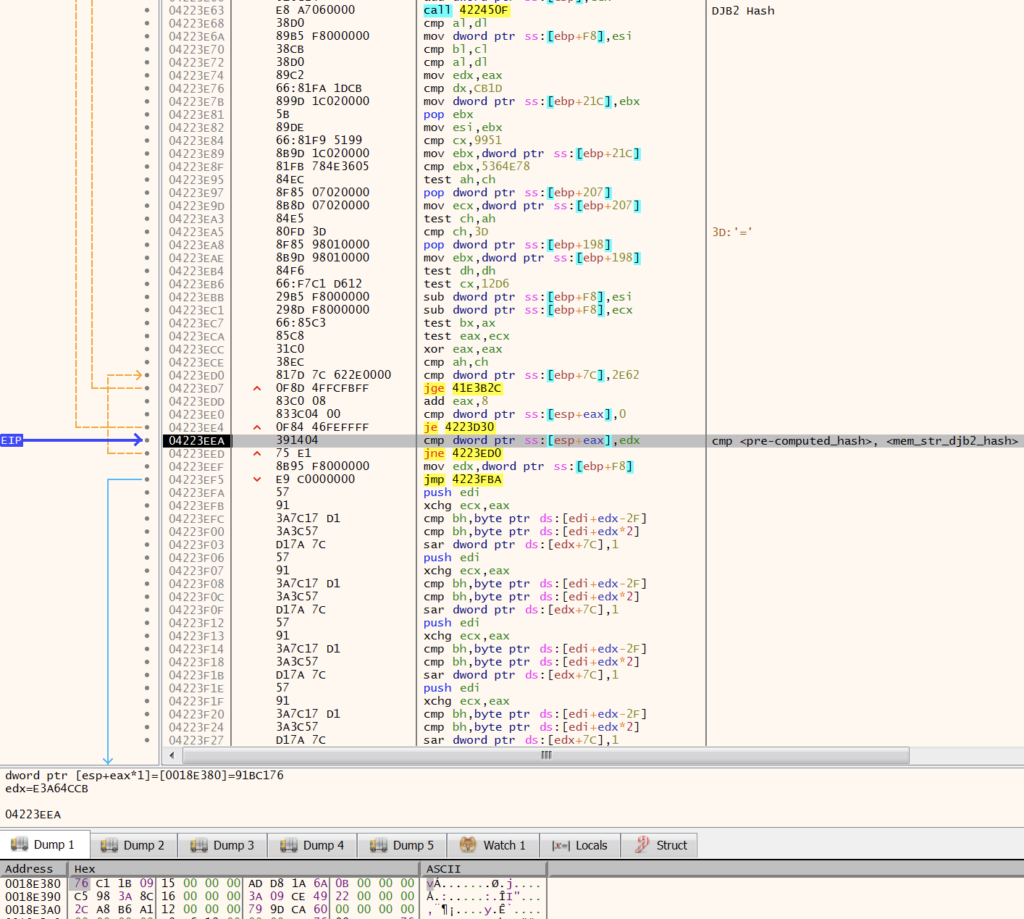
QEMU Agent Detection
GuLoader uses CreateFileA to check for of C:\Program Files\Qemu-ga\qemu-ga.exe and C:\Program Files\qga\qga.exe to identify the QEMU emulator.

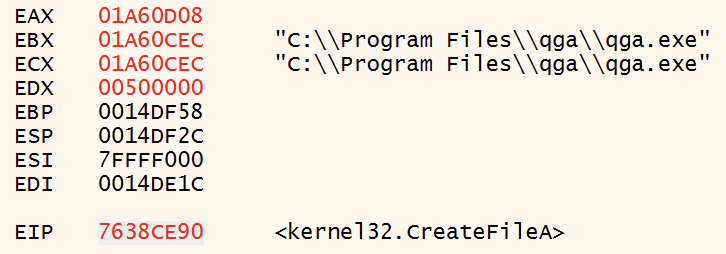
DbgBreakPoint and DbgRemoteBreakin
GuLoader gets the address of DbgBreakPoint and patches the first byte 0xCC (int3) with 0x90 (nop), meaning breakpoints will no longer pause execution in the debugger.
Note: Setting a breakpoint on this function inserts a CC at the beginning of the function, negating this anti-debug technique.

0x90DbgUiRemoteBreakin
The DbgUiRemoteBreakin API is used by the debugger to break in to a process. GuLoader patches this API to ensure that the process cannot be attached to for debugging by replacing the beginning of the API with a call to ExitProcess.

Patch ldrLoadDll
GuLoader patches the initial bytes of LdrLoadDll, presumably to prevent hooks.

Unhooking API Calls
AV and EDR products insert hooks into commonly used NTDLL API functions, allowing the security tool to monitor API calls and arguments to monitor for malicious behavior. User mode hooks are generally inserted in the form of an unconditional jump, replacing the initial 0xB8 mov instruction with a jump 0xE9 to the handler. GuLoader identifies and removes these hooks by searching for byte patterns (\xB8\x00.{3}\xB9) common of those in NTDLL functions.

If a hook is identified, GuLoader replaces the first 5 bytes to remove any hooks.

GuLoader uses 0x33C9, 0xC2, and 0xE8 as anchor bytes in order to retrieve relative byte positions in order to patch.
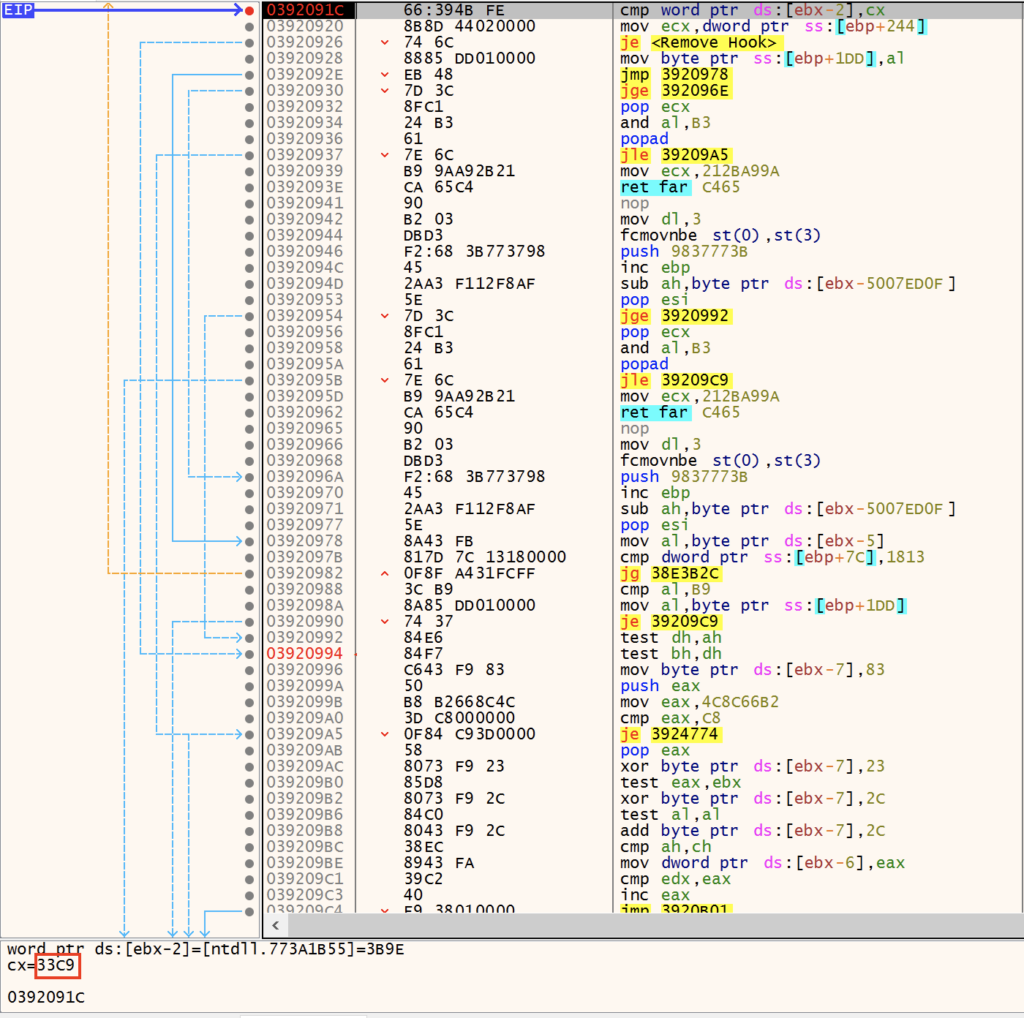
GuLoader calls ZwProtectVirtualmemory to change the page permissions back to PAGE_EXECUTE_READ (0x20) once it has finished replacing any hooks.

PAGE_EXECUTE_READ 0x20EnumWindows
GuLoader uses the Windows API EnumWindows to enumerate all top-level windows on the user’s screen to attempt to identify an analysis/sandbox environment. If the number of windows is less than 12, it calls TerminateProcess to terminate itself.
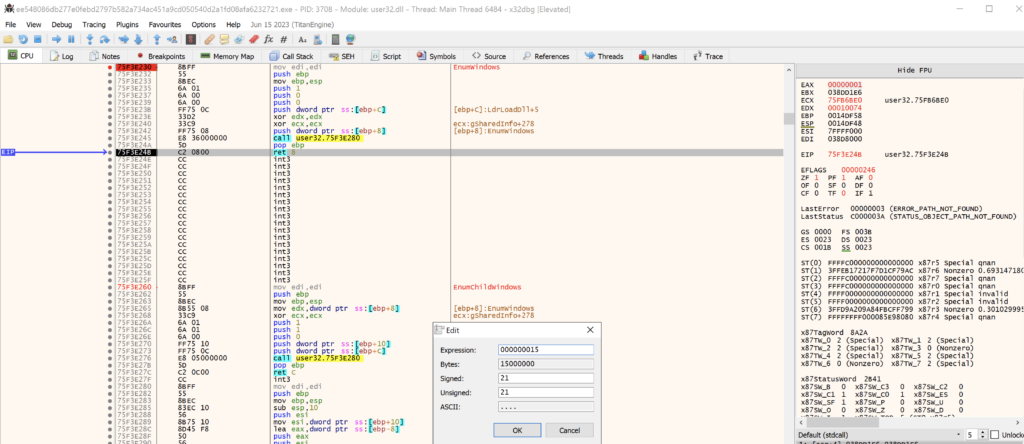
NtSetInformationThread
The Windows API NtSetInformationThread is used to modify thread specific data for a provided thread.
__kernel_entry NTSYSCALLAPI NTSTATUS NtSetInformationThread(
[in] HANDLE ThreadHandle,
[in] THREADINFOCLASS ThreadInformationClass,
[in] PVOID ThreadInformation,
[in] ULONG ThreadInformationLength
);GuLoade calls NtSetInformationThread and passes 0x11 as the argument for ThreadInformationClass. 0x11 corresponds to ThreadHideFromDebugger. This is a known anti-debug technique that causes the debugger to crash when a breakpoint is hit in the specified thread or when the debugger steps through instructions.

Enumerate Device Drivers
GuLoader uses EnumDeviceDriver and GetDeviceDriverBaseNameA from psapi.dll to enumerate system driver names, searching for VM-related drivers. Similar to the methodology used to search for strings, GuLoader uses DJB2 to hash each driver name and compares it to a list of pre-computed hashes.


Enumerate Installed Products
GuLoader uses MsiGetProductInfoA and MsiEnumProductsA to enumerate installed software, hashes the name of the software, and compares them to a list of pre-computed hashes.

Enumerate System Services
GuLoader enumerates system services using OpenSCManagerA and EnumServiceStatusA, hashes the service names, and compares them to a list of pre-computed hashes.

NtQueryInformationProcess
NtQueryInformationProcess is a Windows API that retrieves information about the specified process.
__kernel_entry NTSTATUS NtQueryInformationProcess(
[in] HANDLE ProcessHandle,
[in] PROCESSINFOCLASS ProcessInformationClass,
[out] PVOID ProcessInformation,
[in] ULONG ProcessInformationLength,
[out, optional] PULONG ReturnLength
);Among the process information available, the ProcessInformationClass provides the ProcessDebugPort (0x7), which provides the port number of the debugger for the process. A nonzero value indicates that the process is being run under the control of a ring 3 debugger. If a debugger is detected, the malware exits.
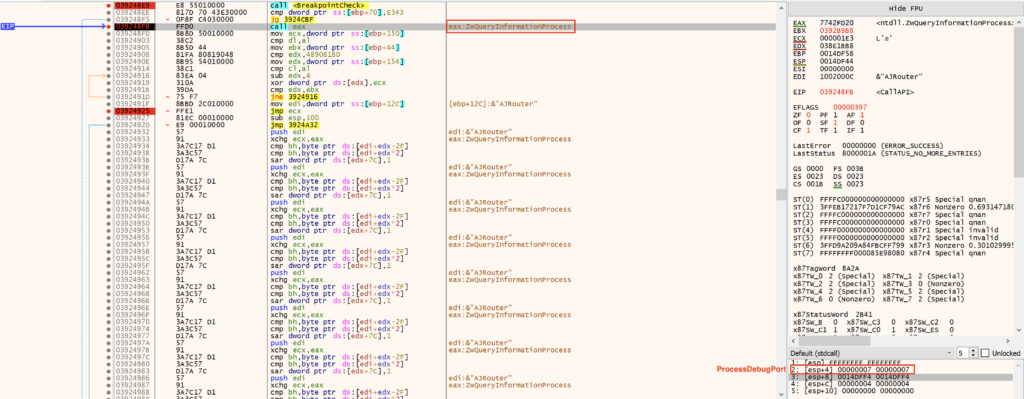
CPUID & RDTSC Sandwich
GuLoader calls CPUID leaf 1 (eax == 1)and checks whether a hypervisor is present by checking bit 31 of register ECX, indicating the malware is running in a virtual environment. This CPUID call is wrapped in rdtsc instructions, which GuLoader uses to calculate the amount of time needed to execute the CPUID call. This is another measure to detect a virtual environment, as a hypercall is required to execute the CPUID instruction within a virtual environment, therefore taking a longer amount of time to execute than on a virtualized system.

String Decryption
GuLoader decrypts all strings at runtime, making static analysis difficult. NtAllocateVirtualMemory is called to allocate a buffer to store the encrypted and decrypted data. Once the buffer is allocated, the length of the encrypted string is written to the first word. Next, the encrypted data is written to the buffer, overwriting the length. GuLoader iterates through the ciphertext, XORing each byte by the key. The decrypted byte is then written back to the buffer in place.

Code Injection
GuLoader uses process hollowing in order to inject code into a suspended process, then resume execution inside the new process. GuLoader has been observed using process hollowing injection into a number of different executables, as well as spawning a child process of itself to inject into. In the case of this sample, GuLoader injected into a copy of itself using the following APIs.
CreateProcessInternalW
GuLoader first calls CreateProcessInternalW, passing its own path as an argument, as well as the creation flag of 0x4 (Suspended). GuLoader uses a direct syscall rather than calling the API directly to avoid EDR/AV detection.


NtUnmapViewOfSection
GuLoader uses NtUnmapViewOfSection to unmap the image at 0x400000 in the suspended process.

NtOpenFile
GuLoader decrypts the path to C:\Windows\System32\mshtml.dll and opens a file handle to it using NtOpenFile.

C:\Windows\System32\mshtml.dllNtCreateSection
After opening a handle to mshtml.dll, GuLoader calls NtCreateSection using the file handle received from NtOpenFile in order to create a section object. A section object represents a section of memory that can be shared with other processes. A section object that is not backed by a file is suspicious, so GuLoader hardcodes a file to create the section object to avoid potential detection.
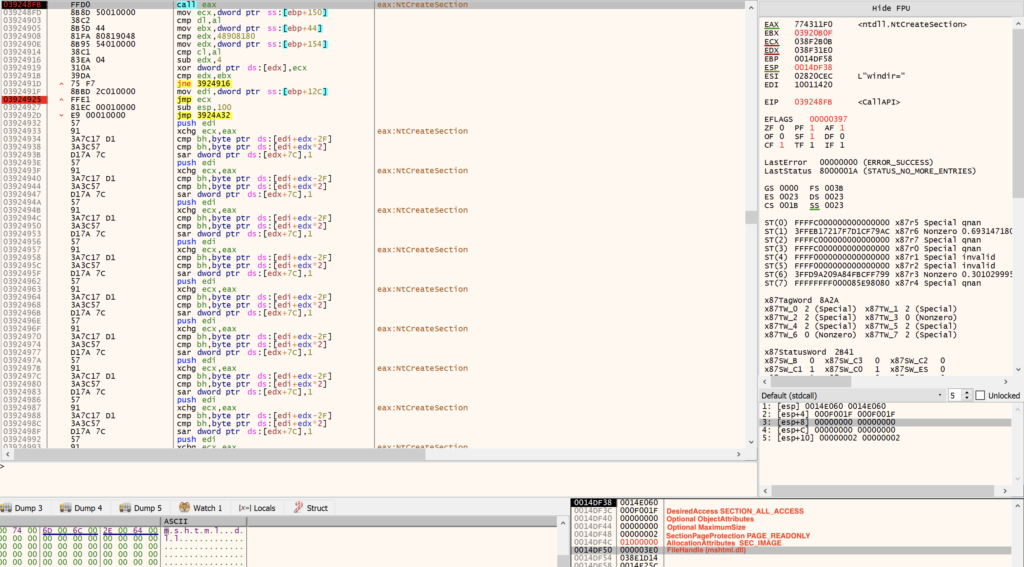
NtMapViewOfSection
Next, GuLoader calls NtMapViewOfSection to map the mshtml.dll section that was just created using NtCreateSection into the virtual address space of the suspended process.
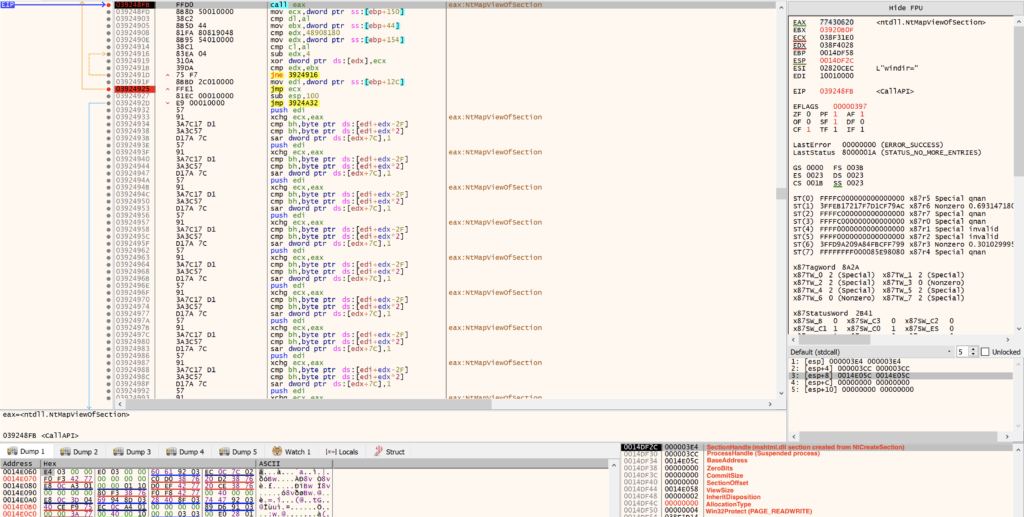
mshtml.dll to memory
ZwWriteVirtualMemory
After the image is mapped in the suspended process, GuLoader writes its shellcode into the memory of the suspended process. Note: The shellcode is not written into the mapped section. The payload will be mapped over it later on.
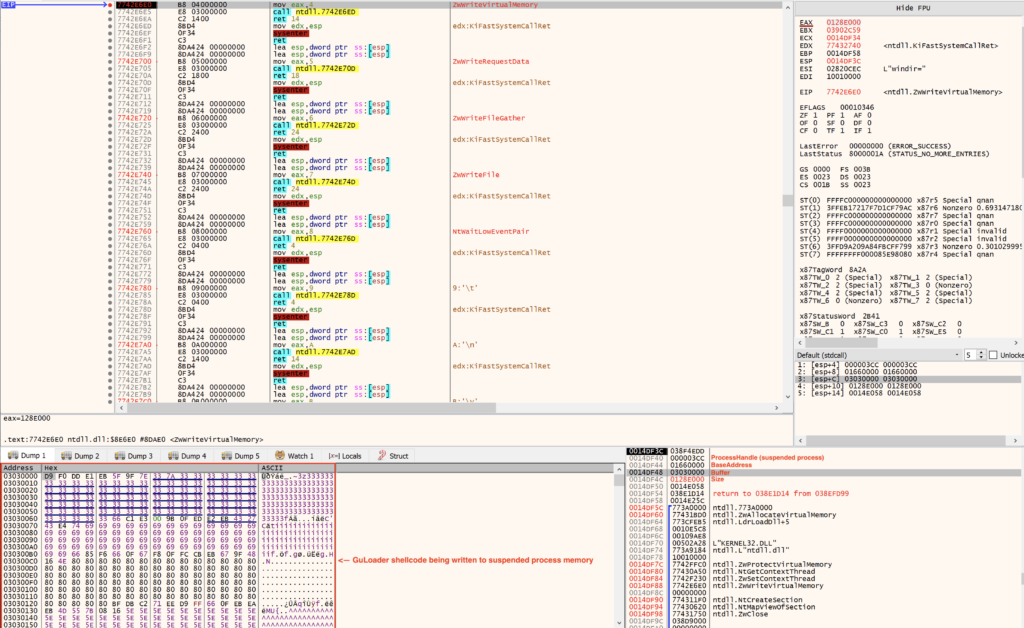
NtGetContextThread
Next, GuLoader calls NtGetContextThread to retrieve a pointer to the Context structure of the thread in the suspended process. This is the same context structure as discussed in the VEH section and contains processor-specific register data.
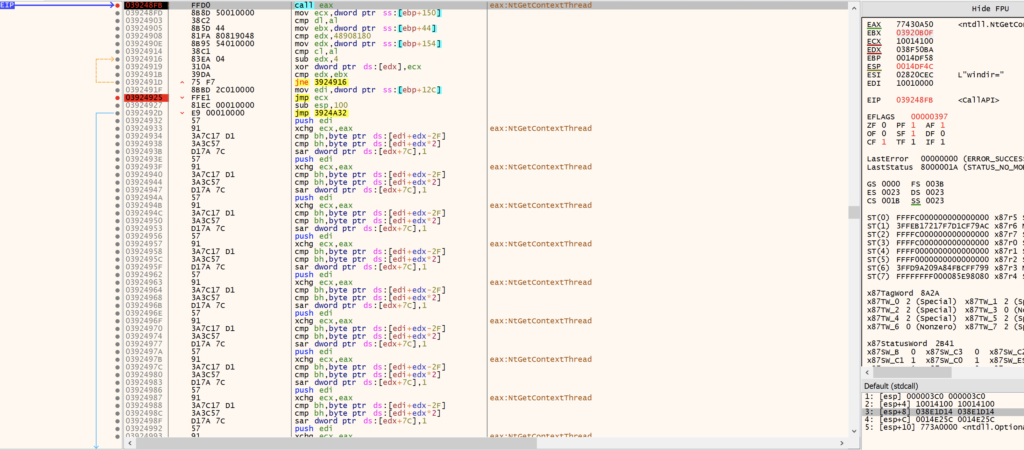
ZwSetContextThread
GuLoader calculates an entry point for the suspended process and updates the EAX register (RtlUserThreadStart is EIP and will jump to the address in EAX). in the context structure retrieved with NtGetContextThread. If abnormal execution is detected, GuLoader will set a decoy entry point, breaking execution in the new process.
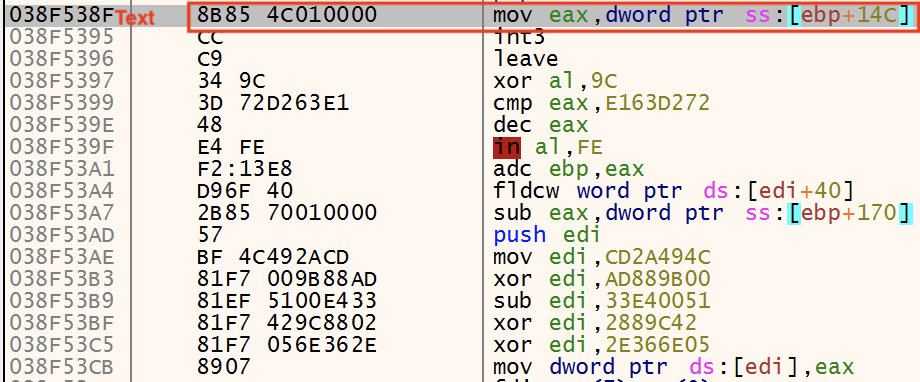
Once the entry point is calculated, GuLoader calls ZwSetContextThread to set the thread context in the suspended process.

NtResumeThread
Finally, GuLoader calls NtResumeThread to resume execution of the suspended process, executing the injected GuLoader shellcode.
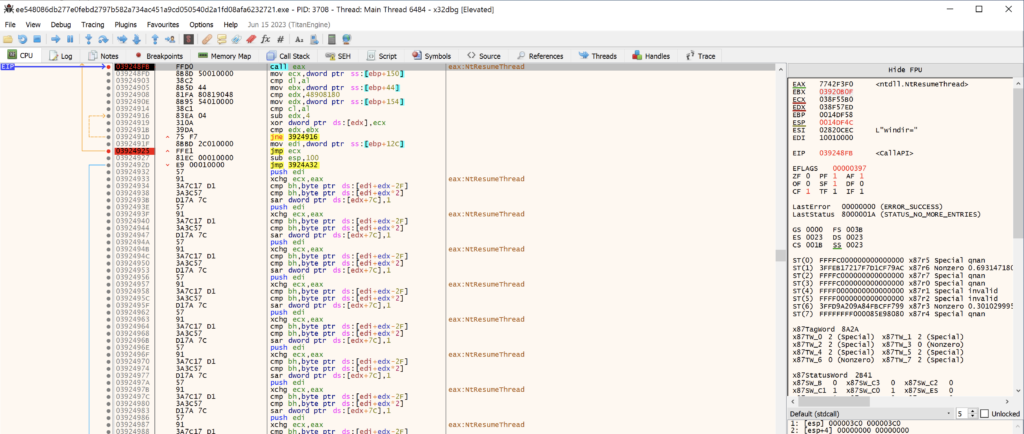
Payload Download and Execution
Decrypt C2
GuLoader resumes execution in the new process, repeating all anti-analysis and anti-vm checks covered above. Once completed, GuLoader decrypts the C2 in memory using the same decryption methodology mentioned above.

If the fifth byte of the C2 is an ‘s’, GuLoader replaces the prefix to https://. Otherwise, it replaces the prefix with http://.

https:// prepended to C2Download Payload
GuLoader resolves the addresses of the following APIs InternetOpenA, InternetSetOptionA, InternetOpenUrlA, InternetReadFile, InternetCloseHandle in order to perform a GET request and download the payload. GuLoader payloads are frequently hosted on Google Drive and other cloud storage and file-sharing solutions. Payloads are generally long-lived as the payloads are XOR encrypted, making it difficult for providers to detect and remove them.

InternetOpenUrlA in process of downloading payloadDecrypt Payload
GuLoader’s decryption routine consists of three steps:
- Calculate XOR key
- Decrypt payload key
- Decrypt payload
Calculate XOR Key
When calculating the XOR key, GuLoader retrieves the first two bytes from the payload, which start at byte offset 40. The two bytes are then XORed against the first two bytes of the encrypted key as well as a counter value. This process is repeated until the first two bytes of the payload are decrypted to 0x4D5A (MZ). When the first two bytes of the payload are 0x4D5A, the value in the counter register is used as the decryption key for the payload key. For this sample, the XOR key is 0x8BF7.


Decrypt Payload Key
With the XOR key now calculated, GuLoader moves to a routine to decrypt the payload key. The decryption routine iterates through the downloaded payload 2 bytes at a time, XORing against the two byte XOR key. The length of the payload key in this sample is 468 bytes.


Decrypt Payload
After the payload key is fully decrypted, GuLoader finally XOR decrypts the downloaded payload in place, byte-by-byte using the 468 byte payload key.


Execute Payload
Zero Base Address 0x400000
Once the payload has been decrypted, GuLoader sets memory permissions at 0x400000 to RW and zeroes out the image that is in place.

Copy Payload to Base Address
Next, GuLoader copies the new payload to 0x400000.

0x400000NtCreateSection
GuLoader then calls NtCreateSection to create a section object so that it can map the image to memory.
NtMapViewOfSection
After the section is created, GuLoader maps the section into memory, then calls ZwProtectVirtualMemory to set memory protection appropriately.

NtCreateThreadEx
Finally, GuLoader calls NtCreateThreadEx to execute the image that is now mapped at 0x400000, executing the payload.
Bonus: Remcos Configuration Extraction
The payload downloaded by this sample of GuLoader is Remcos. Remcos is a commercial Remote Access Tool advertised as legitimate software for surveillance and penetration testing, though it is frequently used in malware campaigns.
I previously wrote a Remcos configuration extractor for another project and it looks like the configuration storage has not changed. The configuration extractor can be found on my GitHub.
❯ python3 extract_config.py remcos_payload.bin
Remcos Config Extractor - CRITICAL Extracting config from: remcos_payload.bin
Malware Family: Remcos
Botnet: RemoteHost
C2s: ['194.59.218[.]165:2408']